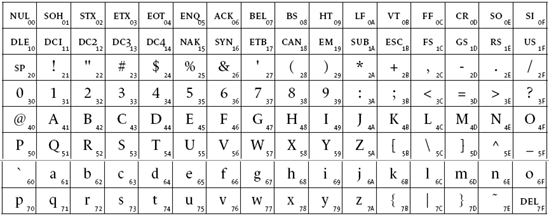1.2. ASCII
Towards the end of the 1950s, the telecommunications industry redoubled its efforts to develop a standard encoding. IBM and AT&T were among the large corporations that drove the ASA (American Standards Association) to define an encoding. Thus ASCII-1963, a preliminary version of ASCII with no lower-case letters, was born on June 17, 1963, a few months after the assassination of President Kennedy.
ASCII was updated in 1967. From that time on, it would include lower-case letters. Here is ASCII-1967:

The first thirty-two positions in this encoding are occupied by control codes:
formatting control codes: CR (carriage return), LF (line feed), BS (backspace), HT (horizontal tab), VT (vertical tab), SP (blank space), FF (form feed);
extension codes: ESC (escape is a shift but modifies only the following character), SO (shift out), SI (shift in);
controls for communications: SOH (start of heading), STX (start of text), ETX (end of text), EOT (end of transmission), ETB (end of transmission block), ACK (acknowledge), NAK (negative acknowledge), SYN (synchronous idle), NUL (null), DLE (data link escape);
device control functions DCI, ..., DC4;
functions for error management: CAN (cancel), SUB (substitute), DEL (delete), BEL (bell).
Of the characters that do not represent controls, a few call for some explanation:
The backslash '\', used by DOS as a delimiter for directory paths and ...
Get Fonts & Encodings now with the O’Reilly learning platform.
O’Reilly members experience books, live events, courses curated by job role, and more from O’Reilly and nearly 200 top publishers.

